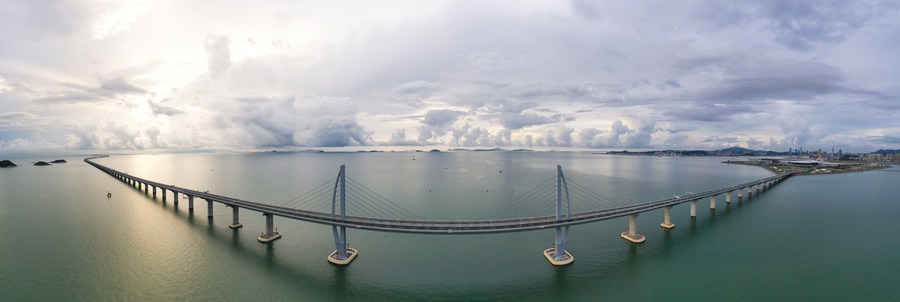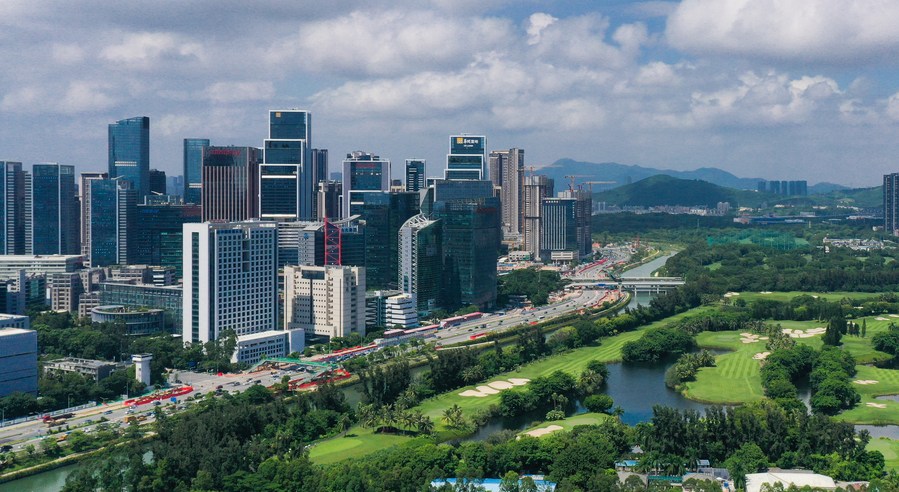 Aerial panoramic photo taken on Sept. 12, 2020 shows the Hong Kong-Zhuhai-Macao Bridge in south China. (Xinhua/Chen Yehua)
Aerial panoramic photo taken on Sept. 12, 2020 shows the Hong Kong-Zhuhai-Macao Bridge in south China. (Xinhua/Chen Yehua)
The development of China's urban clusters has been organic and spontaneous, reflecting a paradigm change of the country's urban planners, and the general trend also applies to the GBA, Alain Bertaud, an urbanist at the Marron Institute of Urban Management at New York University, told Xinhua.
by Xu Chi
GENEVA, May 28 (Xinhua) -- China's Guangdong-Hong Kong-Macao Greater Bay Area (GBA) is set to "usher in an unprecedented new era of urban productivity and creativity," a scholar has said.
The development of China's urban clusters has been organic and spontaneous, reflecting a paradigm change of the country's urban planners, and the general trend also applies to the GBA, Alain Bertaud, an urbanist at the Marron Institute of Urban Management at New York University, told Xinhua recently.
 Aerial photo taken on Feb. 24, 2020 shows the Haizhu wetland and the Canton Tower in the distance in Guangzhou, south China's Guangdong Province. (Photo by Xie Huiqiang/Xinhua)
Aerial photo taken on Feb. 24, 2020 shows the Haizhu wetland and the Canton Tower in the distance in Guangzhou, south China's Guangdong Province. (Photo by Xie Huiqiang/Xinhua)
"China's household income has fast increased as a result of bold reforms since 1978, deeply impacting urban expansion and urban shape," said Bertaud.
"Bold policy changes and market forces have been driving the spectacular increase in consumption of residential floor per person in China, which in fact has surpassed some countries with higher GDP (gross domestic product) per capita," he said.
The scholar said he thinks the development of China's recent urban cluster policy is based on "sound urban economics principles," for it "recognizes the efficiency of a new urban form that has spontaneously emerged in China during the last 18 years."
"Comparing the previous city clusters in the world where the traditional forms of urbanization dominate, the GBA has more dispersed population, job distribution, trip origins and destinations," said Bertaud, also former principal urban planner at the World Bank.
 Aerial photo taken on Sept. 27, 2020 shows the science and technology park along the bank of the Dasha River in Nanshan District of Shenzhen, south China's Guangdong Province. (Xinhua/Mao Siqian)
Aerial photo taken on Sept. 27, 2020 shows the science and technology park along the bank of the Dasha River in Nanshan District of Shenzhen, south China's Guangdong Province. (Xinhua/Mao Siqian)
The GBA's connectivity, as measured by the commuting time between major cities, is one of the finest amongst the world's most important urban clusters, he added.
The urbanist said the GBA's future strength lies in its capacity to "integrate a very large labor market which is inherently more efficient than smaller isolated labor markets combined."
According to official data, the population of the GBA totaled more than 72 million at the end of 2019, significantly higher than the 7.2 million of the San Francisco Bay Area (the 2010 Census), and the 37 million of the greater Tokyo Area (2018 estimate by the United Nations). The GBA's demography constitutes its important strength, according to Bertaud.
"Additionally, the urban cluster development of the GBA benefits from the continuation of the spontaneous formation of urban clusters," he said, adding the government provides guidance to "render the already existing organic trend more efficient."
"Eventually the success of the GBA depends to a large extent on speedy and high-capacity transport systems interlinking its cities," the scholar said.
Being optimistic about the GBA's development, Bertaud said, "The extraordinary growth of urban transport in the GBA has changed the connectivity of the entire region and demonstrates that it is possible to create extremely large integrated labor markets." ■




